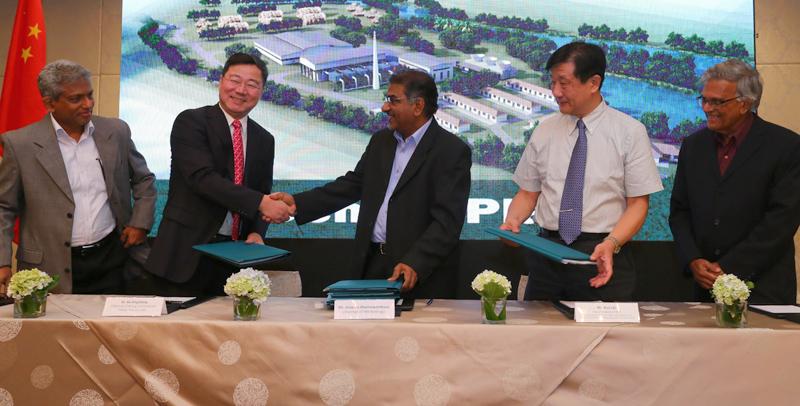
Sri Lanka is to witness its largest dendro power plant of 10 Mega Watts, due to be commissioned in September, following a tripartite joint venture agreement being inked between Sri Lanka’s IMS Holdings and two Chinese private firms on Friday.
According to officials, the upcoming power plant by Green Watts (Pvt) Ltd with an investment of US$25 million being constructed in Kalawaraagama in the Moneragala district is scheduled to be commissioned in September 2018.
“We are proud to announce that we have been able to join hands with Beijing Full Dimension Power Tech Company Ltd and Nanjing Turbine and Electric Machinery Group Company Ltd for this US$25 million project,” Chairman of IMS Holdings (Pvt) Ltd., Jinawara Dharmawardana announced at a launching ceremony at the Mövenpick Hotel in Colombo last week.
Noting that this will be the first power plant to be connected to the newly constructed grid substation in Moneragala, Dharmawardana pointed out that the project will add 70,000 Megawatt hours of renewable energy to the national grid.
The power plant will consist of six biomass boilers and three steam turbine generators as the core of the power generation system.
“In July last year, we signed a 20-year power purchase agreement with the Ceylon Electricity Board and have finalised all the formalities. At the time, we were granted 30 months time to commission the plant,” Dharmawardana said pointing out that the work on the project is well under way with the boilers due to arrive in early March.
Dendro power is the generation of electricity from sustainably grown biomass (fuel wood). It is particularly well suited for tropical countries like Sri Lanka as the fuel wood can be grown rapidly and coppiced once or twice a month.
Dendro using sustainably grown fuel wood can be effectively used to replace the use of fossil fuels for electricity generation and it can also deliver many other socioeconomic and environmental benefits.
“While we had many options for sourcing in this project, we chose the wood of the Gliricidia Sepium tree to produce the fuel as this wood can resist drought, grown on even infertile land and is free from pests.
“Another reason was we believed that the project would benefit hundreds of farmers in the Moneragala district as they will be supplying wood making US$ 3.2 million a year as a result of the power plant,” Dharmawardana elaborated.
He, therefore, pointed out that the project, which leads to the promotion of sustainable agricultural practices by the farmers, would help alleviate poverty in the region by creating many direct and indirect employment opportunities to the local youth.
Chairman of Beijing Full Dimension Power Tech Company Ltd., one of the partners to the agreement, Dr. Xu Xingzhong said, “We are glad to formalise our joint venture agreement with our partners. While we have proceeded with the project development and the initial work on the project so far based on our mutual understandings and agreement, we are now at a stage when all project details, both technical and administrative are in hand.
“Therefore, we consider it prudent to formalize our agreement at this stage to facilitate the balance work on the project implementation and the future operation of the power plant,” he said.
He noted that the cooperation is not just a power generation project but also a “community development project” which will be of “great significance” not only to the partners but also to the two countries.
According to agricultural experts, nitrogen-fixing gliricidia trees can be used as fuel wood as they are fast growing and therefore available in large volumes.
Fuel wood plantations for dendro can be established as a multicrop in home gardens, as an under growth in coconut plantations, as shade for tea plantations and as a multi crop for reforestation. This means that the biomass plantations do not need to replace vital food crops.
The dendro power generation process consists of three steps namely the growth of dedicated forests with fast growing tree species, having high energy yield and secondly regular harvesting of biomass from the forest using coppicing techniques i.e. the tree as a whole is not cut down, but pruned systematically.
Finally, biomass is transported and fed into the furnace of the conventional steam turbine/generator or fed into a gasifier to produce a combustible gas that could be burnt in a diesel engine coupled to an electrical generator.
